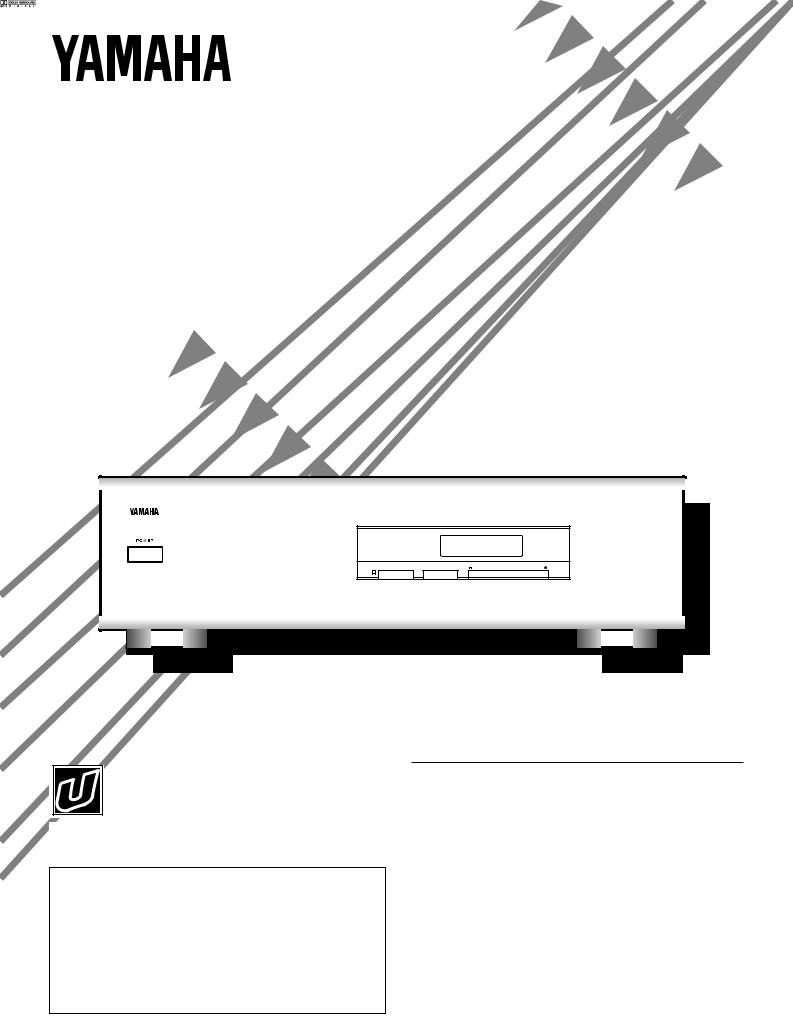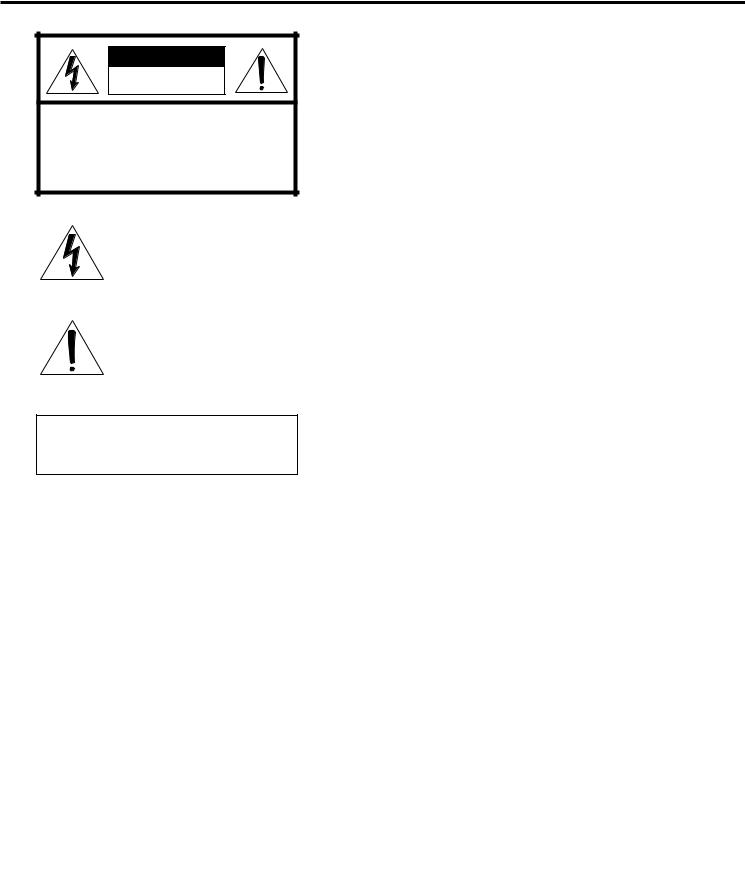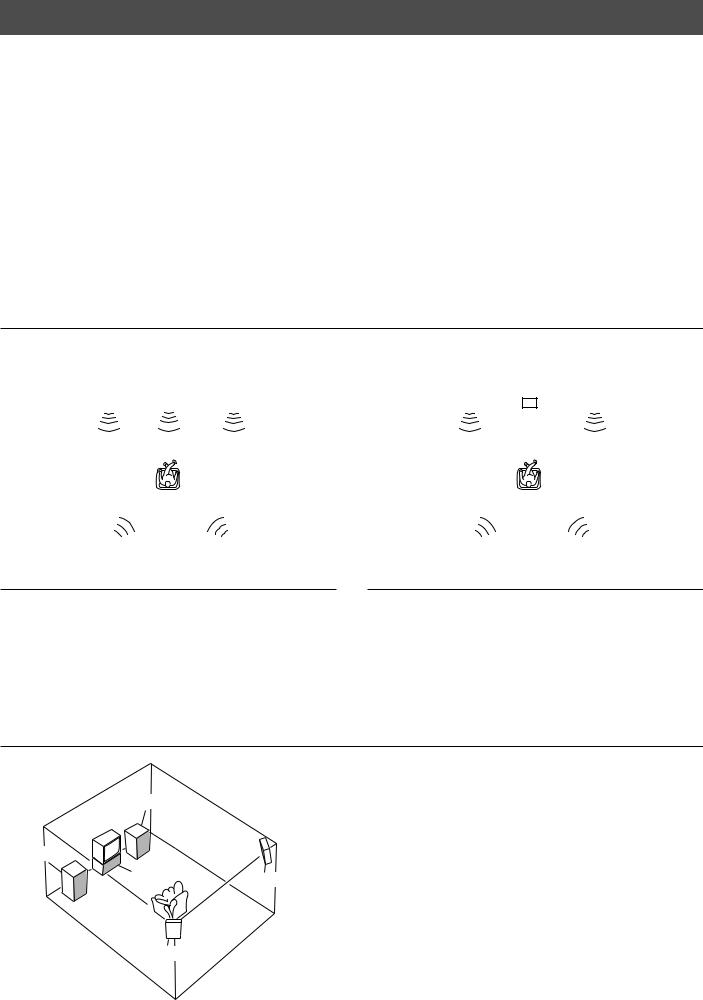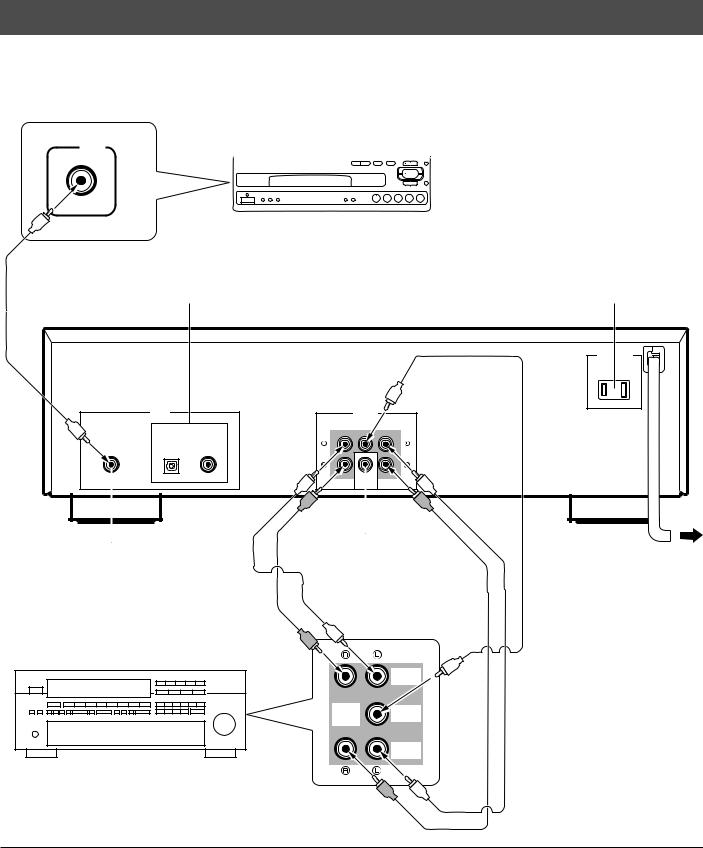Yamaha DDP-1 Owners manual

|
R |
|
|
|
|
|
|
|
|
C |
LS |
|
|
|
|
|
|
RS |
|
|
|
|
|
|
|
LFE |
|
|
|
|
|
|
|
|
|
DDP-1 |
|
|
|
|
|
|
|
|
|
|
|
|
|
NATURAL SOUND DIGITAL PROCESSOR |
|
|
|
|
|
L
R
C |
LS |
|
|
|
RS |
|
|
|
|
LFE |
|
|
|
|
NATURAL SOUND DIGITAL PROCESSOR DDP–1
TEST |
MODE |
MENU |
PARAMETER |
OWNER’S MANUAL
IMPORTANT!
Please record the serial number of this unit in the space below.
Serial No.:
The serial number is located on the rear of the unit. Retain this Owner’s Manual in a safe place for future reference.
CONTENTS |
|
Safety Instructions ......................................... |
2 |
Profile of This Unit ......................................... |
4 |
Speaker System Setup .................................. |
5 |
Connections ................................................... |
6 |
Turning On/Off the Power of This Unit ........... |
8 |
Table of Functions ......................................... |
9 |
Adjustments Before Operation .................... |
10 |
Playing an AC-3 Source .............................. |
14 |
Adjusting Output Levels ............................... |
14 |
Adjusting Delays and Dynamic Range ........ |
16 |
Specifications .............................................. |
18 |
Troubleshooting ........................................... |
18 |
Block Diagram ............................................. |
19 |

SAFETY INSTRUCTIONS
CAUTION
RISK OF ELECTRIC SHOCK
DO NOT OPEN
CAUTION: TO REDUCE THE RISK OF
ELECTRIC SHOCK, DO NOT REMOVE
COVER (OR BACK). NO USER-SERVICEABLE
PARTS INSIDE. REFER SERVICING TO
QUALIFIED SERVICE PERSONNEL.
• Explanation of Graphical Symbols
The lightning flash with arrowhead symbol, within an equilateral triangle, is intended to alert you to the presence of uninsulated “dangerous voltage” within the product’s enclosure that may be of sufficient magnitude to constitute a risk of electric shock to persons.
The exclamation point within an equilateral triangle is intended to alert you to the presence of important operating and maintenance (servicing) instructions in the literature accompanying the appliance.
WARNING
TO REDUCE THE RISK OF FIRE OR
ELECTRIC SHOCK, DO NOT EXPOSE THIS
UNIT TO RAIN OR MOISTURE.
1Read Instructions – All the safety and operating instructions should be read before the unit is operated.
2Retain Instructions – The safety and operating instructions should be retained for future reference.
3Heed Warnings – All warnings on the unit and in the operating instructions should be adhered to.
4Follow Instructions – All operating and other instructions should be followed.
5Water and Moisture – The unit should not be used near water – for example, near a bathtub, washbowl, kitchen sink, laundry tub, in a wet basement, or near a swimming pool, etc.
6Carts and Stands – The unit should be used only with a cart or stand that is recommended by the manufacturer.
6A A unit and cart combination should be moved with care. Quick stops, excessive force, and uneven surfaces may cause the unit and
cart combination to overturn.
7Wall or Ceiling Mounting – The unit should be mounted to a wall or ceiling only as recommended by the manufacturer.
8Ventilation – The unit should be situated so that its location or position does not interfere with its proper ventilation. For example, the unit should not be situated on a bed, sofa, rug, or similar surface, that may block the ventilation openings; or placed in a built-in installation, such as a bookcase or cabinet that may impede the flow of air through the ventilation openings.
9Heat – The unit should be situated away from heat sources such as radiators, stoves, or other appliances that produce heat.
10Power Sources – The unit should be connected to a power supply only of the type described in the operating instructions or as marked on the unit.
11Power-Cord Protection – Power-supply cords should be routed so that they are not likely to be walked on or pinched by items placed upon or against them, paying particular attention to cords at plugs, convenience receptacles, and the point where they exit from the unit.
12Cleaning – The unit should be cleaned only as recommended by the manufacturer.
13Nonuse Periods – The power cord of the unit should be unplugged from the outlet when left unused for a long period of time.
14Object and Liquid Entry – Care should be taken so that objects do not fall into and liquids are not spilled into the inside of the unit.
15Damage Requiring Service – The unit should be serviced by qualified service personnel when:
A.The power-supply cord or the plug has been damaged; or
B.Objects have fallen, or liquid has been spilled into the unit; or
C.The unit has been exposed to rain; or
D.The unit does not appear to operate normally or exhibits a marked change in performance; or
E.The unit has been dropped, or the cabinet damaged.
16Servicing – The user should not attempt to service the unit beyond those means described in the operating instructions. All other servicing should be referred to qualified service personnel.
17Power Lines – An outdoor antenna should be located away from power lines.
18Grounding or Polarization – Precautions should be taken so that the grounding or polarization is not defeated.
2

Caution: Read this before operating your unit
1To assure the finest performance, please read this manual carefully. Keep it in a safe place for future reference.
2Install this unit in a cool, dry, clean place – away from windows, heat sources, sources of excessive vibration, dust, moisture and cold. Avoid sources of humming (transformers, motors). To prevent fire or electrical shock, do not expose the unit to rain and water.
3Do not operate the unit upside-down. It may overheat, possibly causing damage.
4Never open the cabinet. If something drops into the set, contact your dealer.
5Do not use force on switches, controls or connection wires. When moving the unit, first disconnect the power plug and the wires connected to other equipment. Never pull the wires themselves.
6Do not attempt to clean the unit with chemical solvents; this might damage the finish. Use a clean, dry cloth.
7To prevent lightning damage, pull out the power cord and remove the antenna cable during an electrical storm.
8When not planning to use this unit for long periods of time (ie., vacation, etc.), disconnect the AC power plug from the wall outlet.
9Be sure to read the “TROUBLESHOOTING” section regarding common operating errors before concluding that the unit is faulty.
10AC outlet
Do not connect audio equipment to the AC outlet on the rear panel if that equipment requires more power than the outlet is rated to provide.
The apparatus is not disconnected from the AC power source as long as it is connected to the wall outlet, even if the apparatus itself is turned off.
FCC INFORMATION (for US customers only)
1.IMPORTANT NOTICE : DO NOT MODIFY THIS UNIT!
This product, when installed as indicated in the instructions contained in this manual, meets FCC requirements. Modifications not expressly approved by Yamaha may void your authority, granted by the FCC, to use the product.
2.IMPORTANT : When connecting this product to accessories and/or another product use only high quality shielded cables. Cable/s supplied with this product MUST be used. Follow all installation instructions. Failure to follow instructions could void your FCC authorization to use this product in the USA.
3.NOTE : This product has been tested and found to comply with the requirements listed in FCC Regulations, Part 15 for Class “B” digital devices. Compliance with these requirements provides a reasonable level of assurance that your use of this product in a residential environment will not result in harmful interference with other electronic devices.
This equipment generates/uses radio frequencies and, if not installed and used according to the instructions found in the users manual, may cause interference harmful to the operation of other electronic devices.
Compliance with FCC regulations does not guarantee that interference will not occur in all installations. If this product is found to be the source of interference, which can be determined by turning the unit “OFF” and “ON”, please try to eliminate the problem by using one of the following measures:
Relocate either this product or the device that is being affected by the interference.
Utilize power outlets that are on different branch (circuit breaker or fuse) circuits or install AC line filter/s.
In the case of radio or TV interference, relocate/reorient the antenna. If the antenna lead-in is 300 ohm ribbon lead, change the lead-in to coaxial type cable.
If these corrective measures do not produce satisfactory results, please contact the local retailer authorized to distribute this type of product. If you can not locate the appropriate retailer, please contact Yamaha Electronics Corp., U.S.A. 6660 Orangethorpe Ave, Buena Park, CA 90620.
The above statements apply ONLY to those products distributed by Yamaha Corporation of America or its subsidiaries.
We Want You Listening For A Lifetime (for US customers only)
YAMAHA and the Electronic Industries Association’s Consumer Electronics Group want you to get the most out of your equipment by playing it at a safe level. One that lets the sound come through loud and clear without annoying blaring or distortion – and, most importantly, without affecting your sensitive hearing.
Since hearing damage from loud sounds is often undetectable until it is too late, YAMAHA and the Electronic Industries Association’s Consumer Electronics Group recommend you to avoid prolonged exposure from excessive volume levels.
3

PROFILE OF THIS UNIT
Thank you for purchasing the Yamaha DDP-1, a sophisticated digital sound processor designed specifically for decoding Dolby AC-3.
This unit consists of an AC-3 RF demodulator, an AC-3 decoder and other original Yamaha functions developed using the newest technology to reproduce AC-3 encoded sources precisely as movie sound creators intended. AC-3 will lead listeners into a totally new sound experience.
This unit is equipped with “discrete” terminals for sending AC-3 multi-channel audio signals individually. The audio amplifier or receiver must have “discrete” input terminals to receive the signals from the DDP-1. The use of Yamaha RX-V2090, a multi-channel audio/video receiver equipped with discrete input terminals combined with this unit is an ideal choice for the purpose of experiencing AC-3 sound, and this is the best system we recommend.
What’s Dolby AC-3?
Dolby AC-3 is a new generation of multi-channel digital audio technology, or the newest spatial sound processing format developed for 35 mm film-movies by employing a new kind of low bit-rate audio coding.
Dolby Surround AC-3 is a digital surround sound system that provides completely independent multi-channel audio to consumers.
In multi-channel form, Dolby Surround AC-3 provides five full range channels in what is sometimes referred to as a “3/2” configuration: three front channels (left, center and right), plus two surround channels. A sixth bass-only effect channel is also provided for output of LFE (low frequency effect), or low bass effects that are independent of other channels. This channel is counted as 0.1, thus giving rise to the term 5.1 channels in total.
Compared to Dolby Pro Logic that is referred to a “3/1” system (left front, center, right front and just one surround channel), Dolby Surround AC-3 features two surround channels, called stereo or split surrounds, each offering the same full range fidelity as the three front channels.
Sound of wide dynamic range reproduced by the five full range channels presents listeners much excitement that has never been experienced before. Precise sound orientation by the discrete digital sound processing expands realism that the original movie possesses.
Laser Disc is a home audio format that could benefit from Dolby AC-3. In the near future, Dolby AC-3 will also be applied to DBS, CATV, DVD and HDTV. The ongoing release of Dolby Stereo Digital theatrical films now underway will provide an immediate source of AC-3 encoded video software.
Manufactured under license from Dolby Laboratories Licensing
Corporation. “Dolby”, “AC-3”, and the double-D symbol |
|
are |
trademarks of Dolby Laboratories Licensing Corporation. Copyright 1992 Dolby Laboratories, Inc. All rights reserved.
Features of this unit
•Dynamic range (sound scale) of source can be changed so that it will be suitable for the listening conditions.
•Output of low bass from any channel can be assigned to either the MAIN OUTPUT terminals or SUBWOOFER OUTPUT terminal to maximize system performance.
•Output of LFE can be assigned to either the MAIN OUTPUT terminals or SUBWOOFER OUTPUT terminal to maximize system performance.
•Test tone generator helps you adjust speaker level balance.
•Center channel output can be sent to the main speakers if you do not use a center channel speaker.
•Three types of inputs (AC-3 RF, AC-3 Digital Optical and Coaxial) are available for future use.
4

SPEAKER SYSTEM SETUP
As described on page 4, we recommend you to use this unit connecting with the Yamaha RX-V2090. If you have already set up a speaker system for the RX-V2090, you do not need to prepare a new speaker system for this unit. Some functions on this unit have been already preset to be suitable when this unit is used with a speaker system for the RX-V2090. (Refer to page 10 for details about those functions.)
This unit will provide the best performance with a five-speaker system setup: one pair of main speakers for main sound reproduction, one pair of surround speakers for effect and surround sounds and one center speaker for dialog. A simple speaker system excluding a center speaker will still provide impressive ambience and effects, however, and may be a good way to begin with this unit. You can always upgrade to the five speaker system later.
*For the best performance of the RX-V2090, the system needs one more pair of surround speakers at the front position. (Refer to the owner’s manual of the RX-V2090 for details.)
Main speakers should be high performance models and have enough power handling capacity to accept the maximum output of your system.
Surround speakers and a center speaker do not have to be equal to the main speakers. For precise sound localization, however, it is ideal to use high performance models that can reproduce sounds in full range.
If for some reason it is not practical to use a center speaker, you can enjoy AC-3 effect without it. Best results, however, are obtained with the full system.
Speaker system configurations
Five-speaker system |
A simple system without a center speaker |
|||
Main L |
Center |
Main R |
Main L |
Main R |
|
|
|
|
|
|
|
|
|
|
|
|
|
|
|
|
|
|
|
|
|
|
|
|
|
|
|
|
|
|
|
|
|
|
|
|
|
|
|
|
|
|
|
|
|
|
|
|
|
|
|
|
|
|
|
|
|
|
|
|
|
|
|
|
|
|
|
|
|
|
|
|
|
|
|
|
|
|
|
|
|
|
|
|
|
Surround L |
|
Surround R |
Surround L |
Surround R |
||||||||||||
Set the center channel mode (C2. CENTER SP.) to the SML or LRG position. (See page 10.)
Set the center channel mode (C2. CENTER SP.) to the PHANTOM position. (See page 10.)
Note
If you will add a subwoofer in your system that includes the RX-V2090, connect the subwoofer to the “LOW PASS” terminal of the RX-V2090. In doing so, the overall adjustment of speaker output levels including the subwoofer can be done with the master VOLUME control of the RX-V2090.
Speaker placement
|
|
Main: |
In normal position. (The position of your present |
|
|
|
stereo speaker system.) |
Main R |
|
Surround: Behind your listening position, facing slightly |
|
|
|
|
inward. Nearly six feet (approx. 1.8 m) up from the |
|
|
|
floor. |
Main L |
|
Center: |
Precisely between the main speakers. (To avoid |
Center |
Surround R |
|
interference with TV sets, use a magnetically |
|
shielded speaker.) |
||
|
|
||
Surround L
5

CONNECTIONS
•Before attempting to make any connections to or from this unit, be sure to first switch OFF the power to this unit and to any other components to which connections are being made.
•When making connections between this unit and other components, be sure all connections are made correctly, L (left) to L, R (right) to R. Also, refer to the owner’s manual for each component to be connected to this unit.
|
AC-3 laserdisc player or another AC-3 unit |
|||||||||
AC-3 RF OUT |
||||||||||
|
|
|
|
|
|
|
|
|
||
|
|
|
|
|
|
|
|
|
|
|
|
|
|
|
|
|
|
|
|
|
|
|
|
|
|
|
|
|
|
|
|
|
|
|
|
|
|
|
|
|
|
|
|
Audio cord |
Refer to the next page. |
||
(not included) |
|||
|
|
||
|
|
||
(U.S.A. model) |
|
|
|
|
|
||
AC OUTLET |
UNSWITCHED |
I20V 60Hz |
I.6A MAX. |
200W MAX. |
|
INPUT |
|
OUTPUT |
|
|
|
MAIN |
CENTER |
SURROUND |
AC–3 RF |
AC–3 DIGITAL |
|
|
|
|
OPTICAL |
COAXIAL |
|
|
|
|
|
SUBWOOFER |
|
Refer to “Note 2” |
Refer to “Note 1” |
|
|
below. |
To AC outlet |
||
below. |
|||
|
|
Audio cords (included)
LD/TV MAIN
Audio cords (included)
5CH DISCRT INPUT
Amplifier or receiver (RX-V2090 etc.) equipped with 5-ch discrete AC-3 terminals
LD/TV CENTER
LD/TV SURROUND
Note 1) If this unit is connected to the RX-V2090, no |
Note 2) Do not connect a normal audio output terminal of a |
connection is needed to this terminal. By the output |
laserdisc player etc. to this unit’s AC-3 RF terminal. |
mode selections on function C2 to C5, low frequency signals including signals from the LFE channel can be output from the main L and R speakers. (See page 10 for details.)
If the amplifier has a discrete subwoofer input terminal, connect it with this unit’s SUBWOOFER
OUTPUT terminal.
6
